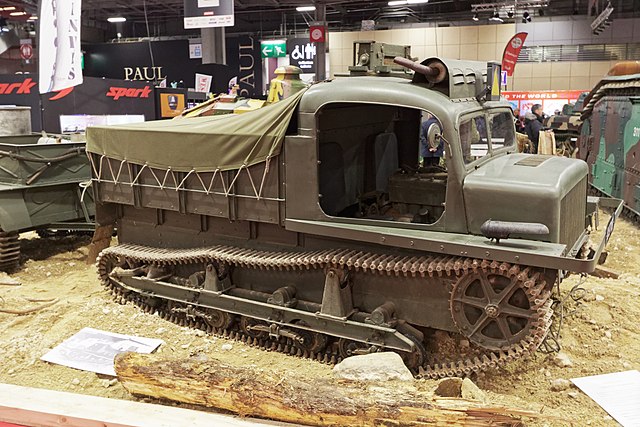Renault TRC-36 (1939)
 Tank Supply Vehicle, about 260 built
Tank Supply Vehicle, about 260 built
Also called Renault YCR, this little tracked tractor was designed as a supplier like the
Renault UE (1932) and based on it's chassis, for resupplying Tanks (TRC stands for "Tracteur de Ravitaillement pour Chars") with a 2.1L 38hp 4 cyl. Renault engine, full metal cab for a driver and co-driver as well as a rear flatbed, towing the same UK trailer. Like the UE, many fell into German hands, in which they served as the Frz. Vollkettenschlepper Renault 36R. It was manufactured until 1942, for the Vichy Army.
Development

The Renault TRC 36R (also called TRC Renault 36R or Renault ACD1 or "tracteur LR 37"), is a far more ellusive and less known vehicle than the earlier UE, which entire lineage, histiory and modifications can be seen in tank afv. The first emerged in 1932 from a specification looking at supplying troops on the battleline, and protect its crew thanks to generous armour. Albeit unarmed, this was enough to have it included not in these pages. The "Tracteur de Ravitaillement pour Chars" (TRC) was however designed in 1935 specifically to supply tanks, not troops, and thus less likely to expect enemy fire. It was unarmoured, unarmed, and thus, deserves to be on truck encyclopedia.
The "tracteur de ravitaillement pour chars Renault 36R" was a planned replacement for the Citroën-Kégresse P17 hald tracks used to supply fuel and ammunition to frontline tanks in 1934, by the tank sub-directorate. The adoption of the Renault UE tankette to supply frontline infantrymen was rejected due to insufficient armor and Renault was pressed to offer a prototype, designated ACD 1. Paradoxically, its EU tractor came without armor and with very simplified bodywork, and a gasoline trailer. This prototype was inspired by the VF tractor, associated with a VJ trailer studied by Renault in 1931. The Army in 1935 decided to adopt and orders the ACD 1, eventually adopted in 1936 as "tank refueling tractor model 1936 R" and 260 were ordered.
The first production TRC were delivered in January 1938 but the bulk of the production, which was very slow was by 1939, albeit still painfully slow as the manufacturer was already inundated with orders. By August 1939, only 12 were delivered and the last came out by January 1940. Production eventuallt was cancelled as the Lorraine 37L tractor proved way superior.
Design of the Renault TRC 36R

Renault to gain time reused many elements of the 1931 UE infantry supply tankette, noth the chassis, drivetrain and engine. Like the original, the 4-cylinder engine (bore × stroke 75 × 120 mm, displacement 2121 cm³) was rated for 38 hp, and was moved forward and reversed so that the cooling depends now of a classic front radiator.
It was derived from the 1920s Renault Primaquatre car and various light trucks for years. There were also six- and eight-cylinder versions of this engine, the latter installed in the AMR 33 and AMC 34 tanks, for example.
Past the truck-like cabin, still quite small and two-seats, the longer fixed all-metal flatbed at the rear was tailored to accommodate tank ammunition boxes, of 75, 47 and 37 shells as well as 7.5 cartridges boxes for a total payload of 822 kg. The front cabin was borrowed from the Renault 1.5 tonne ADK covered van. The UKR trailer associated with the vehicle was developed as a simple evolution of the UK trailer of the Renault UE and was designed to carry fuel, a tank of 450 liters and 18 cans of oil and water as well as 8 grease cans and tooling for 600 kg payload total. Other sources gives the UKR trailer 776 kg empty with a payload of 500 kg.
The TRC 36R had an empty mass of 2.7 t for a total payload, combining the flatbed and trailer of 822+600 of 1,422t of ammunition and gasoline, oil and maintenance kits. Being fully tracked, the Renault TRC 36 was capable of better off-road performances compared to the previous P17, but it was not very fast, at 35 km/h or even down to 28 km/h fully loaded, with trailer. Indeed,wWith 7 hp/ton, the vehicle was therefore quite underpowered.
Fate
Organically, they were assigned to tank battalions four TRC 36R at each section in each of the three combat companies. Thus, until May 1940, the 260 units were delivered by Billancourt, 182 by February 11, 242 at last on March 1, 1940, and despite it was denied the war program unlike the Lorraine 37L it was assigned to many armor units deployed in particular with the 1st Army poised to Belgium. These supply tractor worked on the rear lines, going from depots, and thus, were less likely to see combat.
Still, many were destroyed and the remainder captured by the Wehrmacht after the French capitulation. The were pressed back into service as the Vollkettenschlepper Renault 36R in the exact same role. However to pull even the 3.7 cm PaK 36, German divisional logged many complaints about the reliability of the vehicle, which often failed completely after just a few hundred kilometers during the Russian campaign in 1941. 8 survived to this day, including one in working order part of the Saumur tank museum collection.
| Specs TRC 36 |
| Dimensions : | 3.15 x 1.7 x 1.9 m. Track: 1.49 m |
| Total weight: | 2700 kg |
| Useful load: | 1400 kg |
| Crew: | 2 |
| Propulsion: | Renault 4-cyl. 2,12L 38 hp/2500 rpm, 4+1 speed GBx |
| Speed: | 35 km/h (28 when loaded with trailer) |
| Range: | Tank 62 L. Range 130 km |
| Production | 260 1939-42 |